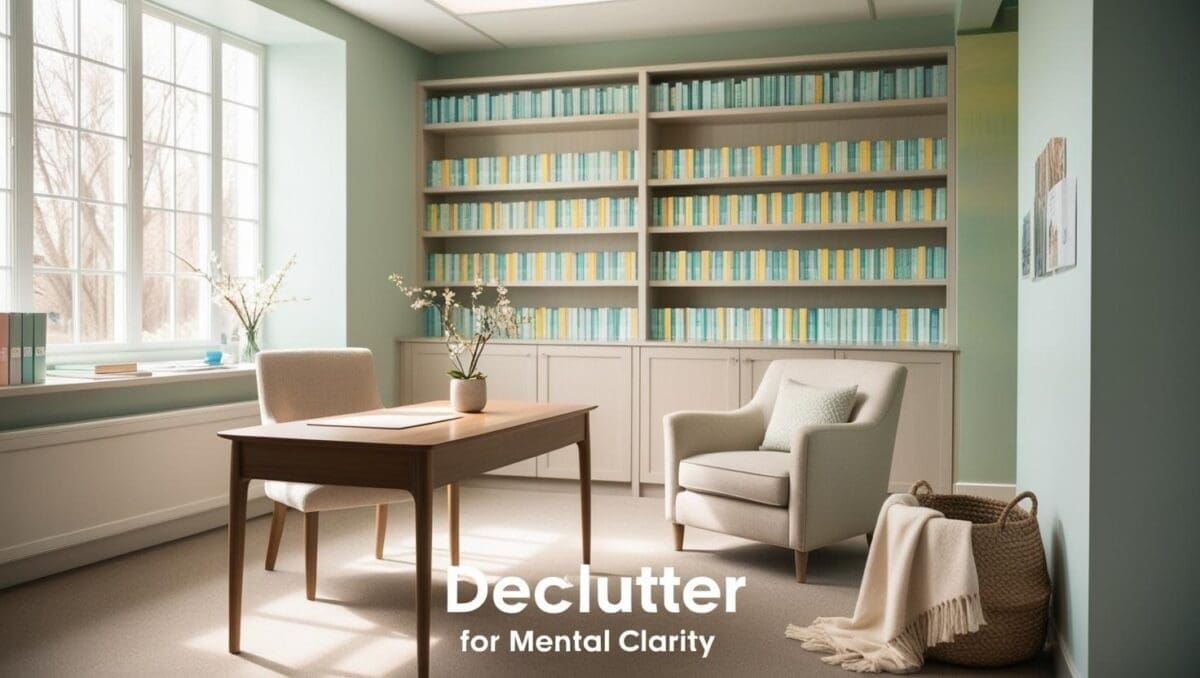Ever notice how your shoulders drop the moment you step into a thoughtfully designed therapy room? That isn’t an accident. Therapy office décor can lower anxiety, strengthen the therapeutic alliance and even speed healing. In this guide you’ll learn exactly how to design a space that works as hard as you do—no interior-design degree required.
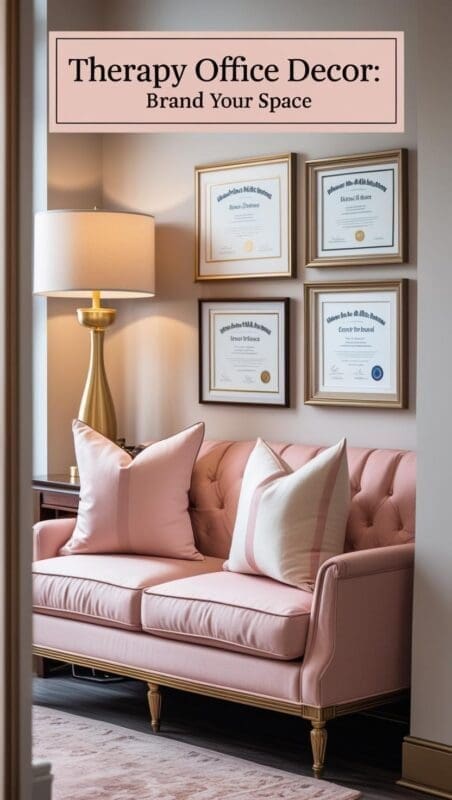
Why Room Design Shapes Client Outcomes
First impressions count. Clients form opinions in just seven seconds. A welcoming room can boost rapport before a single word is spoken.
Environment matters to results. A 2023 qualitative study found that comfort, brightness and focus points in a therapy room directly influence client engagement and disclosure.
Nature heals. Patients with a window view of trees left hospital almost a day sooner than those staring at a brick wall.
Design reduces stress. Biophilic elements—plants, wood, natural light—lower cortisol and heart rate, improving mental-health outcomes.
Choose a Healing Palette
Colour is often called a “silent therapist.” Blues and greens promote calm, while warm neutrals add safety and comfort. A 2024 systematic review concluded that strategic colour use improves patient comfort and satisfaction.
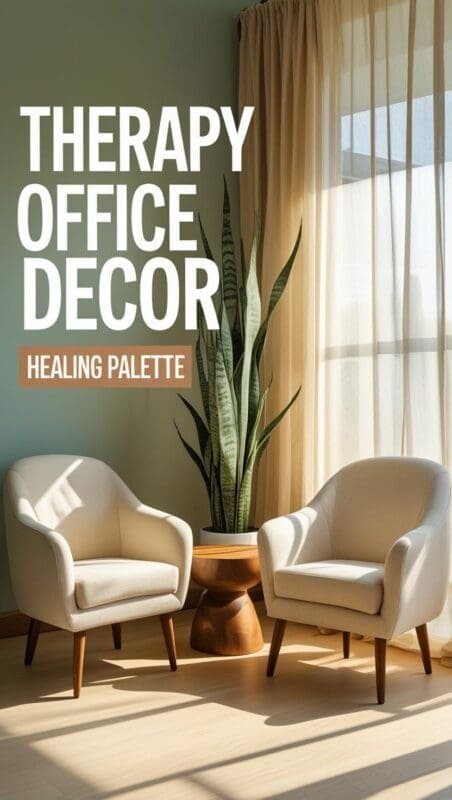
| Goal | Colour family | How to apply |
|---|---|---|
| Reduce anxiety | Dusty greens, pale blues | Paint one accent wall or add throw pillows. |
| Encourage focus | Muted earth tones | Use on rugs or window treatments. |
| Lift mood (pediatrics/PT) | Warm yellows, soft corals | Add through art prints or toy bins. |
Let There Be (Natural) Light & Biophilia
Daylight synchronises circadian rhythms, reduces depression scores and shortens recovery times. If windows are limited, install full-spectrum LED bulbs (around 4000 K) and hang a large landscape print opposite the client’s chair to create a “perceived window.” Add at least one hardy plant—snake plant, pothos or ZZ—for the same biophilic benefits and cleaner air.
Furniture & Zones: Function Meets Comfort
- Seating geometry — Place two armchairs at 10 o’clock and 2 o’clock (≈ 1.5 m apart) to respect personal space while maintaining connection.
- Storage — Closed cabinets or baskets hide clutter, keeping cortisol in check.
- Movement space — In PT or OT rooms, leave a clear 1 m path for demonstrations.
- Play corner — Layer a 120 × 180 cm rug to mark the kids’ zone and dampen sound.
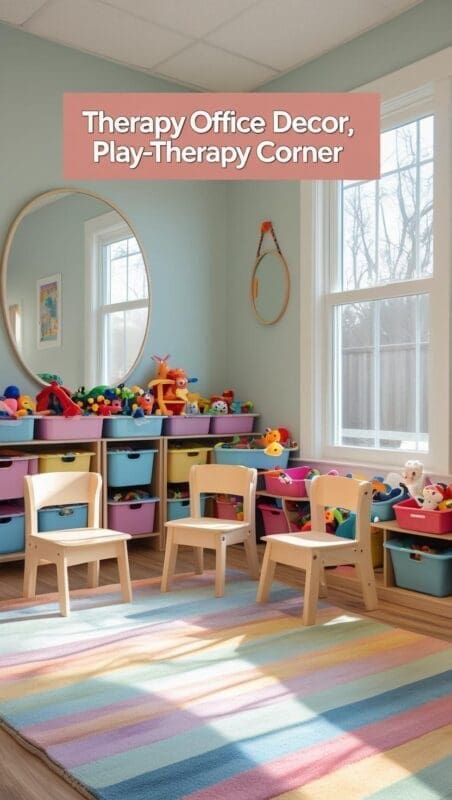
Personal Touch vs Professional Boundaries
Clients want to know you’re human—just not too human. Aim for two to three framed credentials behind your desk, one shelf with up to three personal items (a travel photo, favourite book, small award) and skip family photos to keep boundaries clear.
Small-Space, Big-Impact Hacks
- Mirrors double perceived size and bounce light.
- Floating desks fold away between sessions.
- Vertical storage keeps floors clear and minds uncluttered.
- Ceiling-hung plants add greenery without stealing square footage.
Budget Décor Upgrades (All Under €100)
| Item | Why it Works | Est. € |
|---|---|---|
| Peel-&-stick shiplap (3 m²) | Texture = warmth | 45 |
| Smart dimmer switch | Adjustable mood lighting | 30 |
| Live snake plant | Air-purifying, low care | 15 |
| Essential-oil diffuser + lavender | Scent cue for calm | 10 |
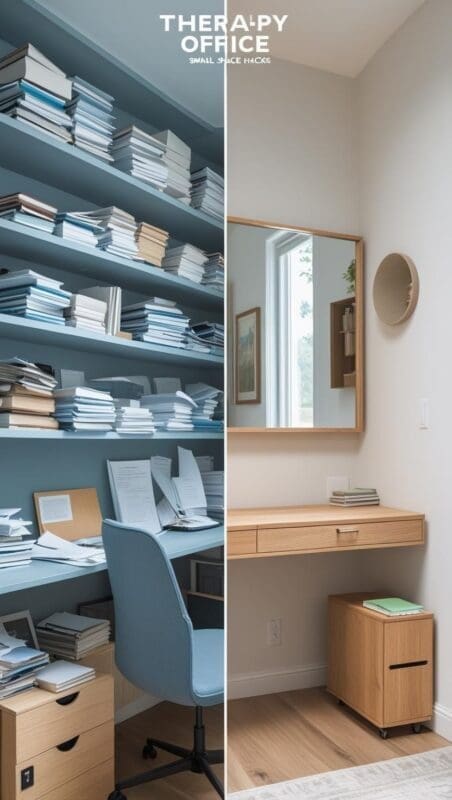
Specialty Tips
Private-Practice Branding
Add two accent cushions in your brand colours to create instant visual consistency from website to waiting room.
Speech Therapy & Pediatrics
Mount a child-height mirror for articulation drills and self-recognition exercises.
Physical Therapy
Invest in a height-adjustable stool and wall-mounted stretch bands. Clear floor space is clinical gold.
Maintenance & Seasonal Refresh Checklist
- Dust weekly and wipe plant leaves monthly.
- Launder textiles every four weeks (yes, even throw blankets).
- Swap cushion covers or artwork each quarter to signal renewal.
- Conduct a six-month “sit test”: experience the room from the client chair and note any wear or visual clutter.
Key Takeaways
A science-backed therapy office décor plan boosts trust, reduces stress and may even speed client progress. Start with colour, light and layout; layer in biophilic touches and personal accents.
FAQ
What colours are most calming in a therapy room?
Soft greens and blues reduce anxiety and promote relaxation, while neutral earth tones add warmth.
How can I decorate a tiny therapy office?
Use fold-down desks, mirrors and vertical storage to maximise floor space without sacrificing style.
Does décor really affect therapeutic outcomes?
Yes—client engagement and disclosure rise in comfortable, well-lit rooms.
What are budget décor ideas for new private practices?
Smart bulbs, peel-&-stick wall treatments and hardy plants each cost under €50 and make a big impact.
How often should I refresh my décor?
Review accents seasonally and complete a deeper refresh every 12 months.
Now cue the scent of lavender, dim the lights to 35 %, and watch your room start doing half the therapeutic work for you.

About the Author
Hi, I’m Eve, a former school counselor with a master’s degree in School Psychology and a passionate advocate for children and families navigating sensory challenges. As a mom of children with sensory sensitivities, I deeply understand the journey special-needs parents face, and I dedicate myself to researching and sharing practical solutions to help children thrive and feel comfortable in their bodies. My goal is also to empower counselors, therapists, and psychologists with creative strategies and supportive resources to enrich their everyday practice. When I’m not writing or exploring new therapeutic approaches, you’ll find me spending quality time with my family and continually seeking inspiration from everyday moments.

